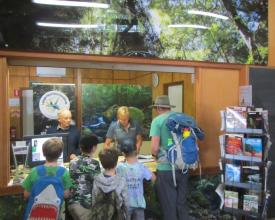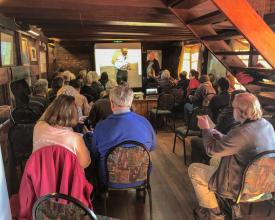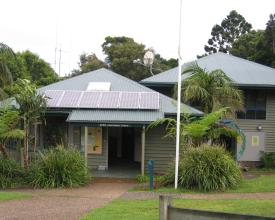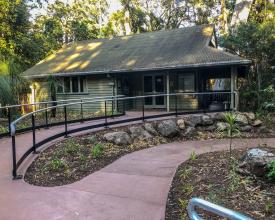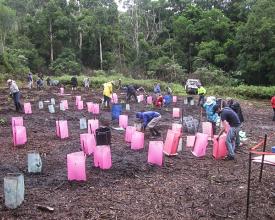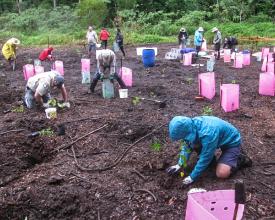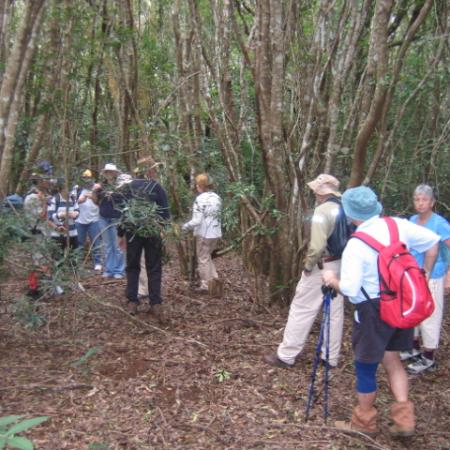
Lamington National Park’s long-term volunteers
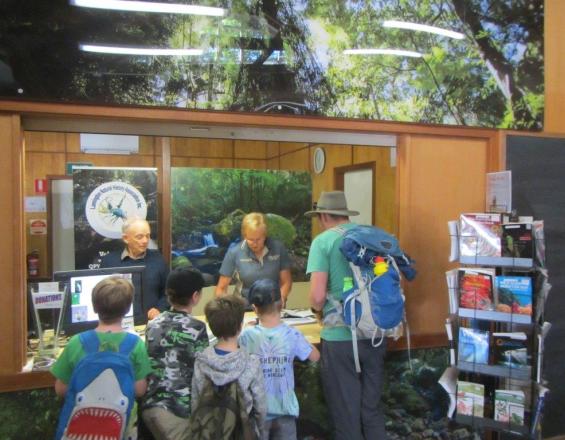
Lamington National Park, traditional land of the Danggan Balun (Five Rivers) People, is part of the World Heritage, Gondwana Rainforests of Australia. Lamington Natural History Association (LNHA) and Green Mountains Natural History Association (GMNHA) are volunteer organisations that provide information to visitors on Lamington National Park and take part in volunteer activities that contribute to the park’s conservation and management. The associations have been running for over 40 years, in partnership with Queensland Parks and Wildlife Service & Partnerships (QPWS&P). Members volunteer on weekends and school holidays at QPWS&P's Binna Burra and Green Mountains Visitor Centres, and undertake revegetation and fund raising for projects on park. This partnership has positive effects for the park through protecting and enhancing the parks natural, social and cultural values, improving safety of park visitors while increasing support and knowledge of the park, its values and conservation.
Contexto
Défis à relever
Lamington National Park is 21,000ha of mountainous terrain ranging from below 700m to 1050m above sea level, with over 130 kilometres of graded tracks as well as remote walking trails with limited accessibility other than ‘on foot’. Maintaining the track system is labour and resource intensive. Remote bushwalking can be hazardous to visitors without the right information, physical fitness and preparedness. One of the main challenges for addressing these issues is limited budget and staffing, resulting in a lack of ranger presence on weekends and during peak visitor periods. This limits the capacity to provide local, current knowledge of park conditions to visitors, as well as park opportunities and it’s special values, resulting in an increase of visitor impacts and decreased visitor safety.
Ubicación
Procesar
Summary of the process
For this solution to work as well as it has, a mutual desire for positive conservation outcomes is one of the key drivers. The strong relationship that has been developed between QPWS&P and the volunteer organisation members is mutually beneficial and built on trust. The Volunteer Agreements support this relationship and assist in ensuring the responsibilities and boundaries of the relationship are clear to all involved, which reduces the risk of relationship breakdown. Volunteer agreements enable an increased trust among all partners, encouraging greater input and ensuring its longevity. Having a positive relationship and volunteer agreement makes undertaking collaborative projects and programs easier, provides better information to visitors through educational and interpretive materials, delivers a safer on park experience for visitors and encourages positive relationships with park neighbours which has a positive flow on effect for other park management decisions.
Building Blocks
Establishing and enhancing Queensland Parks and Wildlife Service & Partnerships (QPWS&P) and community relationships
The relationship between protected areas staff and the community is important for effective protected area management. The rapport Queensland Parks and Wildlife Service & Partnerships (QPWS&P), particularly rangers have with the local community, including the natural history association volunteers provides a suite of benefits for Lamington National Park and conservation.
The reciprocal relationship the associations have with QPWS&P sees the department providing the volunteers with QPWS&P volunteer uniforms, accommodation and meeting rooms, maintenance of the visitor centres, resources for other activities and a volunteer accreditation weekend every 2 years. The accreditation weekends span a full two days with accommodation, catering, guest speakers and venue supplied or arranged by QPWS&P. Guest speakers often include both QPWS&P and external experts in the field of environmental management. In return, the volunteers staff volunteer centres on weekends and school holidays providing park information to visitors and participating in park conservation projects.
Enabling factors
QPWS&P and volunteers have a relationship built on trust and a mutual respect for what each organisation can contribute to the ongoing management of Lamington National Park. Open and respectful communication with a positive attitude and clearly set responsibilities and boundaries.
Lesson learned
Building and maintaining relationships with community volunteers in park management is enhanced by ensuring formalised, regular accreditation. By giving back to the volunteers and providing consistent messaging promotes longevity of the relationship and builds trust.
Develop Memorandum of Understandings between Queensland Parks and Wildlife Service & Partnerhsips (QPWS&P) and volunteer organisations
Volunteer agreements (Memorandum of Understanding) exist between each association (LNHA and GMNHA) and the Queensland Parks and Wildlife Service and Partnerships (QPWS&P). The agreements sets out the roles and responsibilities of both parties. Although they are not legally binding, it establishes the commitment of the department and volunteers that has contributed to the longevity and growth of the relationship.
Enabling factors
It is important that the Volunteer Agreements are clear and supported, and capture the requirements and aspirations of both parties while being mutually beneficial. It must cover all the important parts of the negotiated agreement and be in line with legislation and government policies. It sets out the duties and responsibilities of all involved, including financial arrangements.
Lesson learned
A successful volunteer agreement needs flexibility built into it so that it can be informally adapted over time as required. Communication also needs to be open and transparent while developing the agreement.
Provide and support conservation projects and programs to strengthen relationships and enhance park values
The purpose of this building block is to have relevant projects that provide a benefit for Lamington National Park. Examples include revegetation projects, public events, education programs and materials. By working together with the community and volunteer organisations, projects can be guided/developed to benefit Lamington National Park and its stakeholders. Having structured projects and programs provide volunteers with a purpose for their time and also assist in implementing the management plan for the park.
Enabling factors
It is important that projects and programs are appropriate and work towards park management goals; are do-able by the volunteers; have a high chance of achieving success; and have a purpose understood by and supported by all involved.
Lesson learned
Conservation projects and programs must be tailored to the age and skill set of the volunteers. Park staff must also have realistic expectations about the supervisory role they play. The outcomes of the projects need to also be desirable by all parties so everyone is working towards their aspirations.
Impacts
Volunteers provide park information and safety messaging to visitors and assist visitors on park activities on weekends when Rangers aren’t present.
The associations generate funding by selling their own products at the information centres and taking donations, which feed back into park management and conservation. For example, funding for a 200m, wheelchair accessible wooden boardwalk at Green Mountains to provide better access to view the forest values. The also acquire external funding and grants as well, for example a A$25 000 grant through the Friends of Parks small grants program by the Queensland Government, supporting the 2015 Lamington National Park Centenary project.
Volunteers gather information that assists rangers in their work improving efficiency and saving resources. For example, a logbook kept by the associations at the volunteer centres provides information recording information such as visitor numbers entering the information centres, incidents on park, day use area and facilities use, track condition reports and overall impression of visitation to the park. This provides quicker responses to safety issues, and improved operational activities to address emerging issues while maintaining the 130 kilometre walking track system. Volunteers on park assists rangers in understanding weekend impacts and demand on the park when they are not able to be on site.
Beneficiaries
- The community; local, Australian and international visitors.
- Lamington National Park’s values through visitor awareness reducing visitor impacts.
- QPWS&P through improved community relationships, improved efficiency in park management
Sustainable Development Goals
Story

Lamington Natural History Association (LNHA) formed in 1975 with a long history of providing environmental education services to school groups and visitors out of the Environmental Education Centre (EEC) at Binna Burra for many years. LNHA delivered many successful interpretive programs, for example the Lamington Junior Ranger program and Christmas holiday interpretive programs in the 1980s (slide shows and guided walks). They also undertook small natural resource management projects such as removing invasive weeds at Mt Merino and other environmentally sensitive sites.
LNHA volunteers worked out of the old Forestry Hut on Binna Burra lodge land and a tent at the trail head prior to the opening of the Binna Burra Visitor Information Centre in 1988. Binna Burra EEC closed in 1999/2000. LNHA became the first community group to have an official agreement with Queensland National Parks and Wildlife Service back in the day.
A group split from LNHA in 1977 to form the Green Mountains Natural History Association (GMNHA) so a second group could work autonomously on the Green Mountains side of the park. GMNHA started assisting O’Reilly’s Rainforest Retreat with minor construction and interpretation on their Wishing Tree walking track, followed by the construction of the Python Rock track and Tree Top Canopy Walk.
GMNHA originally worked out of a small space at O’Reilly’s on weekends and school holidays, before moving to the Queensland Parks and Wildlife Service & Partnerships (QPWS&P) office in the mid-1980s. The GMNHA moved again to the new QPWS&P Visitor Information Centre in the late 1990s.
Association activities include developing additional publications such as interpretive track guides in languages other than English and supporting rangers on revegetation projects. Regular member weekends are held on park that include special guests discussing natural history topics. The associations also produce their own newsletters which QPWS&P contributes to; facilitating better communication between QPWS&P and association members.
